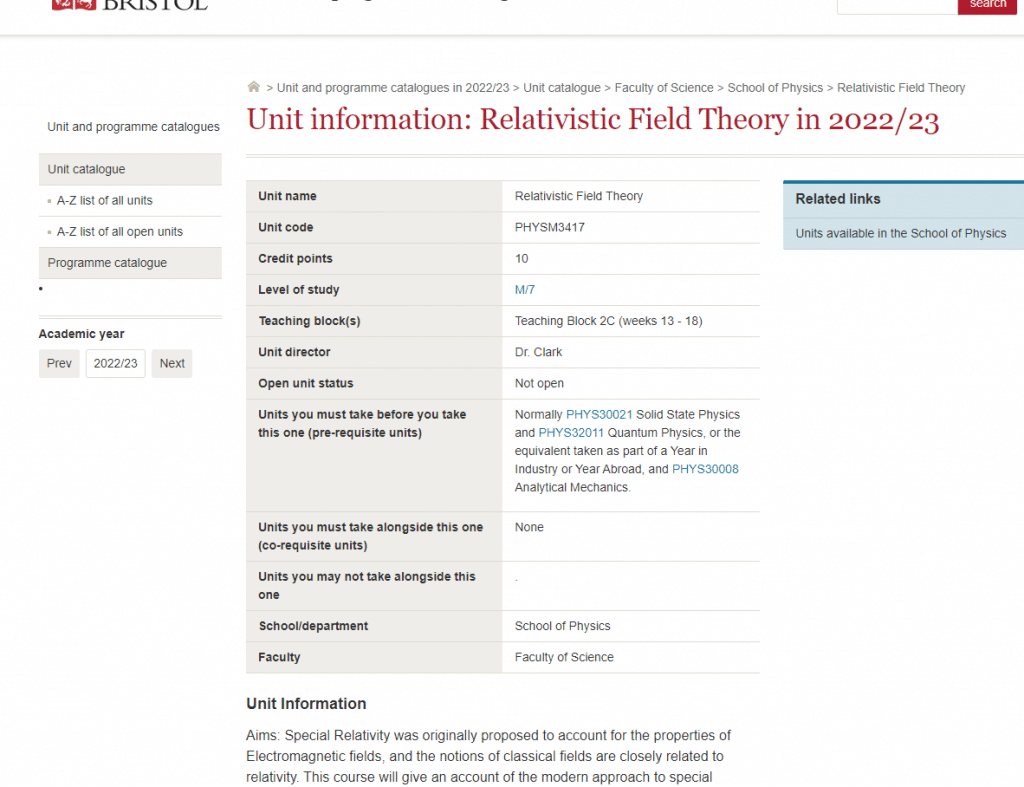Assignment-daixieTM为您提供布里斯托大学University of Bristol Relativistic Field Theory PHYSM3417相对论场理论代写代考和辅导服务!
Instructions:
The course seems to aim to provide a comprehensive understanding of the principles of special relativity and how it relates to the behavior of electromagnetic fields. It appears to cover both the mathematical calculations involved in the theory and the more qualitative aspects of the subject matter.
The course also seems to delve into the covariant description of classical electromagnetic fields, which is an important concept in the modern approach to special relativity. Additionally, the course covers the relativistic quantum Klein-Gordon and Dirac equations, which are crucial for understanding quantum mechanics within the context of special relativity.
Overall, it seems like this course would be of interest to anyone looking to deepen their understanding of special relativity and its various applications in the fields of electromagnetism and quantum mechanics.

Consider the following Lagrangian
$$
\mathcal{L}=-i \bar{\Psi}\left(\gamma^\mu \partial_\mu-m\right) \Psi
$$
Where
$$
\Psi=\left(\begin{array}{l}
\psi_1 \
\psi_2
\end{array}\right), \quad \bar{\Psi}=\left(\bar{\psi}1, \bar{\psi}_2\right) $$ $\psi{1,2}$ are Dirac spinor fields. We will suppress spinor indices throughout.
(a) Show that (1) is invariant under infinitesimal transformations
$$
\delta \Psi=i \epsilon_a T_a \Psi, \quad T_a=\frac{\sigma_a}{2}, \quad a=1,2,3
$$
where $\sigma_a$ are Pauli matrices.
(a) Since the generators $T_a$ are Hermitian, the transformation laws are
$$
\begin{aligned}
& \delta \psi=i \epsilon_a T_a \psi \
& \delta \bar{\psi}=-i \bar{\psi} \epsilon_a T_a
\end{aligned}
$$
The Lagrangian is quite trivially seen to be invariant
$$
\delta \mathcal{L}=-i \delta \bar{\psi}(\partial-m) \psi-i \bar{\psi}(\not \partial-m) \delta \psi=-i \bar{\psi}\left(-i \epsilon_a T_a\right)(\partial-m) \psi-i \bar{\psi}(\partial-m)\left(i \epsilon_a T_a\right) \psi=0,
$$
where we used the trivial relation $\left[T_a, \gamma^\mu\right]=0$.
(b) Find the conserved currents $J_a^\mu$ corresponding to the symmetric transformations.
(b) We use the so called Noether method to find the conserved current, i.e., we pretend that the transformation parameter $\epsilon$ is spacetime dependent. Then
$$
\delta \mathcal{L}=\left(\partial_\mu \epsilon_a\right) \bar{\psi} \gamma^\mu T_a \psi
$$
which implies
$$
J_a^\mu=-\bar{\psi} \gamma^\mu T_a \psi
$$
(c) Write down the corresponding conserved charges $Q_a, a=1,2,3$. Show that
$$
\delta \Psi=i\left[\epsilon_a Q_a, \Psi\right]
$$
(c) The conserved charges are thus
$$
Q_a=-\int d^3 x \bar{\psi}(x) \gamma^0 T_a \psi(x)=\int d^3 x \psi^{\dagger}(x) T_a \psi(x)
$$
In the following we will repeatedly use the relations
$$
\begin{aligned}
{\left[T_a, T_b\right] } & =i f^{a b c} T_c \
\left.\left{\psi_i(x), \psi_j^{\dagger}(y)\right}\right|{x^0=y^0} & =\delta(\vec{x}-\vec{y}) \delta{i j}
\end{aligned}
$$
where $i, j$ are indices in the Lie algebra representation space. We write:
$$
i\left[\epsilon_a Q_a, \psi_k(x)\right]=i \epsilon_a T_{i j}^a \int_{x^0=y^0 \text { choice made }} d^3 x\left[\psi_i^{\dagger}(y) \psi_j(y), \psi_k(x)\right]
$$
Now we use the relation:
$$
[A B, C]=A{B, C}-{A, C} B
$$
which for our case gives $\left(A=\psi_i^{\dagger}(y), B=\psi_j(y), C=\psi_k(x)\right)$ :
$$
i\left[\epsilon_a Q_a, \psi_k(x)\right]=-i \epsilon_a T_{i j}^a \int_{x^0=y^0} d^3 x \delta(\vec{x}-\vec{y}) \delta_{i k} \psi_j(y)=-i \epsilon_a T_{k j}^a \psi_j(x)=-\delta_e \psi_k(x)
$$
